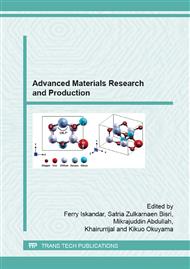p.458
p.462
p.466
p.470
p.474
p.481
p.485
p.489
p.493
Sintering of Mg-Ca-Zn Alloy Metallic Foam Based on Mg-Zn-CaH2 System
Abstract:
Mg-Ca-Zn alloys are promising candidate metal cellular material for biocompatible and biodegradable implant. This is due to its corrosion behavior which enables well controlled degradation, as well as due to the fact that the corrosion product shows no cytotoxicity at all. In this present work, the characteristics of Mg-Ca-Zn alloy metallic foam prepared by the foaming of a powder compact based on Mg-2Zn-Ca and CaH2 system were investigated. Mg-Zn-CaH2 powders with various compositions of 67-96 wt.% Mg, 1.2-30 wt.% CaH2, 9 wt.% Ca and 2 wt.% Zn constant were studied. The prepared powders were then pressed under a load of 26 MPa at room temperature. Sintering process of green compacts was conducted at 350 °C for 2 h continued to 520 °C for 1 h. The sintered green compacts were analyzed by X-ray diffraction (XRD), scanning electron microscopy (SEM) and energy dispersive analysis (EDS). The XRD results showed the sintering process affects the phase formation of Mg, Ca, Mg2Ca, and MgCaZn. Mg2Ca binary phase to be avoided because its leading to reduce mechanical properties of the final product.
Info:
Periodical:
Pages:
474-477
Citation:
Online since:
July 2015
Authors:
Keywords:
Price:
Сopyright:
© 2015 Trans Tech Publications Ltd. All Rights Reserved
Share:
Citation:


